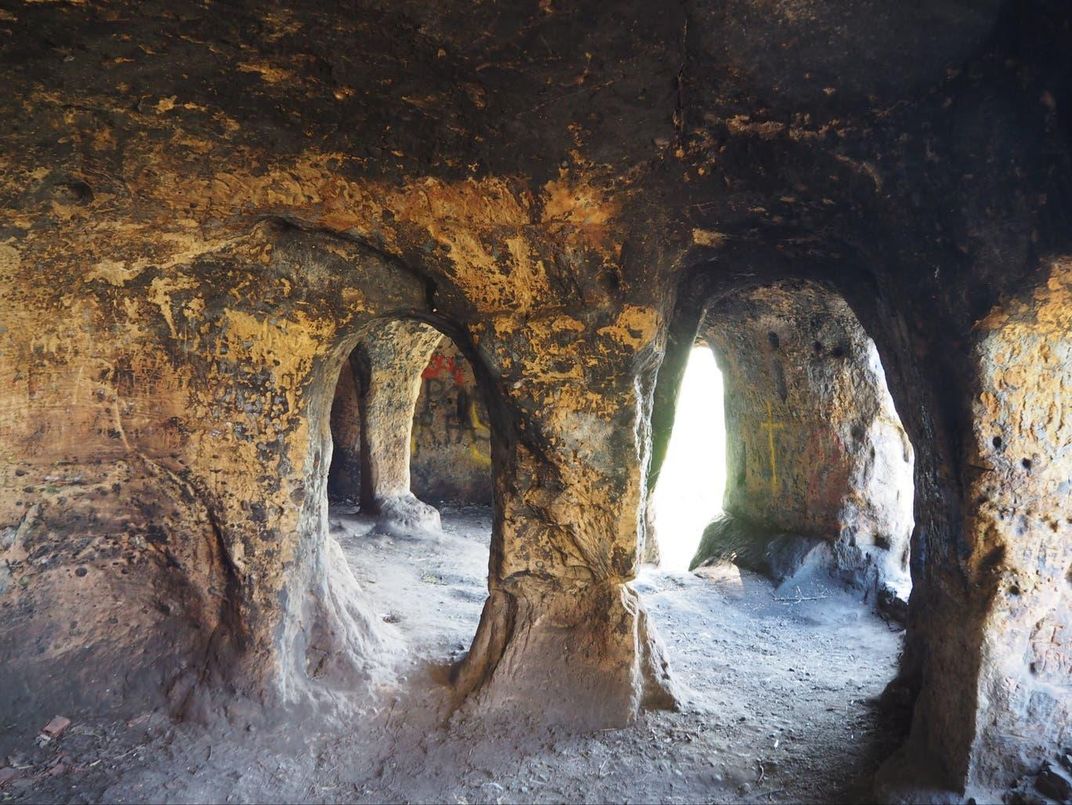Deposed Ninth-Century King May Have Called This Cave Dwelling Home
New research suggests Eardwulf of Northumbria lived in the modified structure while in exile
:focal(684x534:685x535)/https://tf-cmsv2-smithsonianmag-media.s3.amazonaws.com/filer/1a/5e/1a5e4240-77d0-416a-8aba-4ed08b737ca6/rau_anchor_church_cave_pic_3.png)
An early medieval cave structure in Derbyshire, England, may be the former home of a ninth-century king—and the United Kingdom’s oldest intact domestic interior.
As Mark Brown reports for the Guardian, new research conducted by experts from the Royal Agricultural University (RAU) and Wessex Archaeology suggests the 1,200-year-old dwelling once housed Eardwulf, an exiled ruler of the medieval English kingdom Northumbria. The team published its analysis in the Proceedings of the University of Bristol Speleological Society.
“Our findings demonstrate that this odd little rock-cut building in Derbyshire is more likely from the 9th century than from the 18th century as everyone had originally thought,” says lead author Edmund Simons, a research fellow at RAU, in a statement. “This makes it probably the oldest intact domestic interior in the U.K.—with doors, floor, roof, windows etc.—and, what’s more, it may well have been lived in by a king who became a saint!”
Per the statement, researchers previously believed the cave was an 18th-century folly (a type of decorative building constructed to enhance the natural landscape). Though the structure is classified by Historic England as a “[n]atural cave, enlarged and formed into a folly,” Simons tells the Guardian that he “can’t think of a natural process that makes walls, doors and windows, let alone pillars.”
The sandstone-chiseled building features narrow openings characteristic of Saxon architecture, notes BBC News. A nearby ninth-century crypt boasts a comparable rock-cut pillar, perhaps suggesting that the two buildings date to the same period.
To reconstruct the cave dwelling’s original layout—made up of three rooms and an eastern-facing oratory, or chapel—the team drew on precise measurements, a drone survey and an assessment of architectural details.
/https://tf-cmsv2-smithsonianmag-media.s3.amazonaws.com/filer/87/d4/87d42ce2-7065-40ad-80ef-74af6f475b39/218048484_4462936170392469_6290067211111630392_n.jpeg)
Other English churches from the ninth century remain intact, but as Simons tells CNN’s Jack Guy, “there’s nowhere else really where you can walk into somewhere where somebody ate and slept and prayed and lived.”
According to BBC News, local folklore, as well as a fragment of a 16th-century book, hint at a connection between Saint Hardulph—associated with Eardwulf by modern scholarship—and the caves. As the book states, “Saint Hardulph has a cell in a cliff a little from the [River] Trent.”
In the statement, Simons says, “The architectural similarities with Saxon buildings, and the documented association with Hardulph/Eardwulf, make a convincing case that these caves were constructed, or enlarged, to house the exiled king. It was not unusual for deposed or retired royalty to take up a take up a religious life during this period, gaining sanctity and in some cases canonization.”
Per the Independent’s David Keys, Eardwulf ascended to the throne following the murders of his two immediate predecessors. He ruled Northumbria from 796 to 806, when he was deposed. Eardwulf spent his final years in exile in Mercia (another kingdom in the Midlands), ultimately dying in 830, reports Derbyshire Live’s Callum Parke.
During the seventh, eighth and ninth centuries, England had at least seven major kingdoms and 200 kings, as the Independent points out. Most of these monarchs did not leave the throne of their own volition: Up to 16 percent were murdered. Another 16 percent were killed in battle. Thirty-three percent were peacefully removed from power; only a third ended their reigns through natural death.

“The discovery illuminates a particularly fascinating and troubled period in English history,” David Petts of the University of Durham, a specialist in early medieval religious sites, tells the Independent.
Scholars think that Eardwulf’s son and successor probably organized his father’s removal from the throne. The shift in power shift weakened the Northumbrian kingdom, and Eardwulf was forced to live out his days in (relative) isolation.
“[T]his is somebody who would have had disciples with him and would have been revered as holy, probably as a saint in his own lifetime,” Simons tells the Guardian. “He doesn’t have his great feasting hall any more but it is quite a nice [residence].”
Eardwulf was buried at Breedon on the Hill in Leicestershire, around five miles from the caves.
In the 18th century, local landowner Robert Burdett renovated Eardwulf’s former home. Per the statement, the aristocrat added masonry and window frames to the cave so he could invite visitors to its “cool and romantic cells.” As CNN points out, Burdett also expanded entryways to allow tables, drinks and women with wide skirts into the building.
To date, Simons’ team has classified more than 170 cave houses at 20 sites across England’s West Midlands.
“We are confident that other examples are still to be discovered to give a unique perspective on Anglo Saxon England,” says Simons in the statement.
/https://tf-cmsv2-smithsonianmag-media.s3.amazonaws.com/accounts/headshot/Isis_Davis-Marks_thumbnail.png)
/https://tf-cmsv2-smithsonianmag-media.s3.amazonaws.com/accounts/headshot/Isis_Davis-Marks_thumbnail.png)